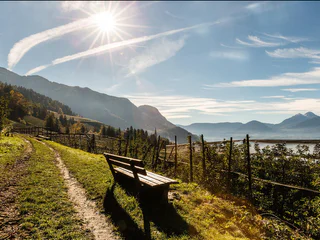
1/4
Hike to Rastlhof Farm
San Giorgio/St. Georgen - Scena/Schenna, Schenna/Scena, Meran/Merano and environs
Během zimních túr po upravených stezkách poznáte klidnou stránku Jižního Tyrolska. Objevte okouzlující vyhlídky v Dolomitech, zasněžené lesy v tichých bočních údolích a vychutnejte si přírodu na vlastní pěst v absolutním tichu. Na sněžnicích se vydáte daleko od sjezdovek a lanovek do nedotčených lesů. Tak se turistika na sněžnicích a zimní turistika stává skutečným zážitkem.

1/4
San Giorgio/St. Georgen - Scena/Schenna, Schenna/Scena, Meran/Merano and environs

1/5
Ortisei/Urtijëi/St. Ulrich/Urtijëi, Urtijëi/Ortisei, Dolomites Region Val Gardena

Sesto/Sexten, Sexten/Sesto, Dolomites Region 3 Zinnen

1/5
Terento/Terenten, Terenten/Terento, Brixen/Bressanone and environs

1/3
Alpe di Siusi/Seiseralm, Kastelruth/Castelrotto, Dolomites Region Seiser Alm

1/2
Caminata di Tures/Kematen, Sand in Taufers/Campo Tures, Ahrntal/Valle Aurina

1/3
Nova Levante/Welschnofen, Welschnofen/Nova Levante, Dolomites Region Eggental

Ridanna/Ridnaun, Ratschings/Racines, Sterzing/Vipiteno and environs

Villabassa/Niederdorf, Toblach/Dobbiaco, Dolomites Region 3 Zinnen

Selva/Sëlva/Wolkenstein/Sëlva, Sëlva/Selva di Val Gardena, Dolomites Region Val Gardena

1/2
S. Candido/Innichen

1/5
Terento/Terenten, Terenten/Terento, Brixen/Bressanone and environs

Sesto/Sexten, Sexten/Sesto, Dolomites Region 3 Zinnen

Sulden/Solda, Stilfs/Stelvio, Vinschgau/Val Venosta

1/2
Presule/Prösels, Völs am Schlern/Fiè allo Sciliar, Dolomites Region Seiser Alm

1/2
San Vigilio, Al Plan/San Vigilio, Dolomites Region Kronplatz/Plan de Corones

1/8
Oris/Eyrs, Laas/Lasa, Vinschgau/Val Venosta

1/4
Monte di Tramontana/Nördersberg, Schlanders/Silandro, Vinschgau/Val Venosta

1/2
Dobbiaco Vecchia/Alttoblach, Prags/Braies, Dolomites Region 3 Zinnen

1/3
Castelrotto/Kastelruth, Kastelruth/Castelrotto, Dolomites Region Seiser Alm

1/2
Luson/Lüsen, Lüsen/Luson, Brixen/Bressanone and environs

Vallesina/Versein, Mölten/Meltina, Bolzano/Bozen and environs

Sesto/Sexten, Sexten/Sesto, Dolomites Region 3 Zinnen

Selva/Sëlva/Wolkenstein/Sëlva, Sëlva/Selva di Val Gardena, Dolomites Region Val Gardena

1/4
La Val/La Val, La Val, Dolomites Region Alta Badia

1/17
S. Osvaldo/St. Oswald - Bolzano/Bozen, Bolzano/Bozen, Bolzano/Bozen and environs

1/6
Montesole/Sonnenberg - Parcines/Partschins, Meran/Merano, Meran/Merano and environs

1/3
San Cassiano/San Cassiano, Badia, Dolomites Region Alta Badia

1/8
Montesole/Sonnenberg - Parcines/Partschins, Partschins/Parcines, Meran/Merano and environs

1/4
S. Pietro/St. Peter - Funes/Villnöss, Villnöss/Funes, Dolomites Region Villnösstal